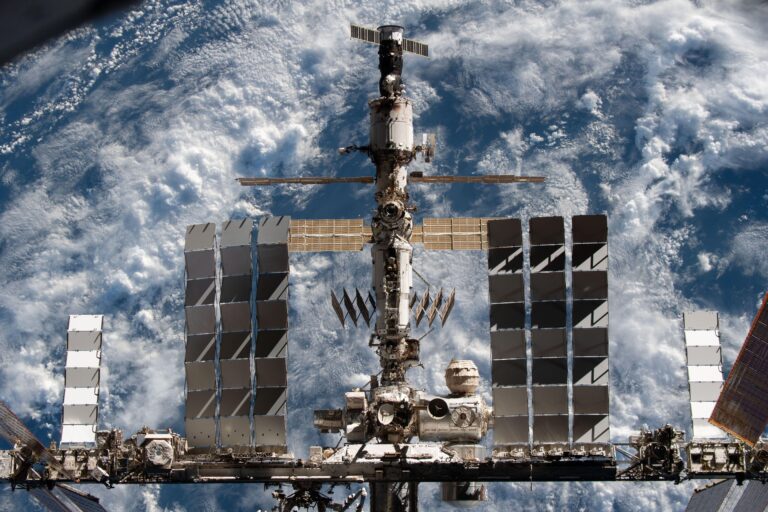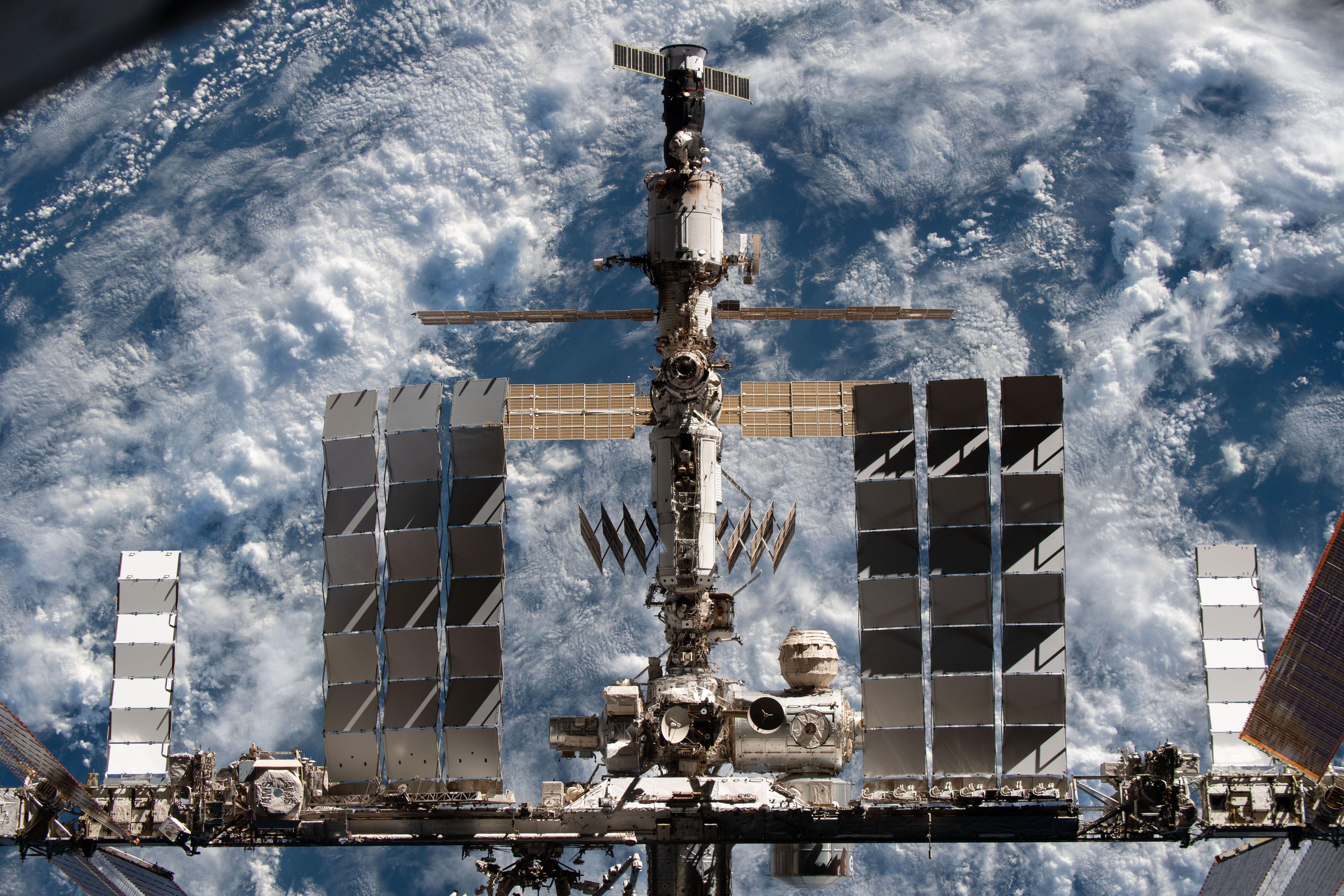
[ad_1]

For nearly a quarter century, the International Space Station (ISS) has continuously hosted astronauts and science experiments as an enduring and beloved bastion of humanity in low-Earth orbit. Yet despite its successes, the space station’s days are numbered.
In the coming months, NASA will be evaluating commercial proposals for vehicles capable of “decommissioning” the ISS—that is, of safely dropping it into Earth’s atmosphere to burn up. The agency has said it expects to pay nearly $1 billion for this service to avoid relying on multiple Russian vehicles. The brutal ending is scheduled for early next decade but is already proving a delicate matter for aerospace engineering and international diplomacy.
The ISS is “a key symbol of international and civilian cooperation,” says Mai’a Cross, a political scientist at Northeastern University. “In terms of civilian cooperation, I think many would describe it as the biggest project ever embarked upon in human history.”
Although it is also supported by Canada, Japan and Europe, the ISS is chiefly a creation of the U.S. and Russia and is one of the very few areas of steadfast cooperation between both nations across decades of rocky relations. Its first modules—one from the U.S., and the other from Russia—reached orbit in late 1998. And the space station’s first crew—one astronaut and two cosmonauts—took up residence in November 2000. The ISS has been constantly inhabited ever since and has far surpassed its original target lifetime of 15 years.
But nothing lasts forever. “Although you hate to see it go, and it’ll be sad when it’s retired, it’s really not practical to keep it on orbit indefinitely,” says George Nield, president of the company Commercial Space Technologies and a former member of NASA’s Aerospace Safety Advisory Panel, a long-standing committee that has urged the space agency to develop a clear strategy for the ISS’s demise sooner rather than later.
A Looming Problem
The laboratory’s doom comes from its location in low-Earth orbit, within the tenuous upper reaches of Earth’s atmosphere. There, whatever goes up must come down, pulled back to our planet by a steady wash of speed-sapping atmospheric particles.
Without periodic boosts, as a spacecraft in low-Earth orbit loses speed, it loses altitude as well, eventually sinking deep enough to break apart and burn up as it plunges through our planet’s atmosphere. Most of the ISS’s orbit-maintaining boosts come from a steady supply of Russian Progress cargo vehicles that, once docked with the station, periodically fire their engines to counteract the space station’s constant sinking.
Theoretically, NASA and its collaborators could raise the ISS to an orbit at which it would leave Earth’s atmosphere entirely. But lofting so much mass so high would be extremely expensive. And even if the station were to be abandoned in such a “graveyard orbit,” the ISS would still pose hazards: because it is so old and unwieldy, its eventual disintegration would be inevitable and would generate enormous amounts of debris that could damage other satellites.
“You don’t want to leave it in orbit,” says Jonathan McDowell, an astrophysicist at the Center for Astrophysics | Harvard & Smithsonian, who also monitors satellites in orbit. “It’s very nice to think of it as a museum, but it’s going to deteriorate and break up.” Deconstructing the ISS is also unfeasible, Nield says, because it wasn’t designed for disassembly—and any ad hoc attempt to do so would face dire risks from aging components that have spent more than two decades exposed to the extreme environment of space.
If the space station can’t orbit ever onward, then it must burn out in a blaze of glory. There are two ways that could happen: either in a deliberate, destructive descent into the atmosphere or in what engineers call an “uncontrolled deorbit,” in which the ISS would plummet to Earth’s surface at nature’s whim. And while it might be glorious, that latter option is unquestionably dangerous. The ISS is larger than a football field, and its orbit carries it over 90 percent of Earth’s population. To date, the harm to people and property from falling spacecraft debris has been practically nonexistent—but as the largest object to ever deorbit, the ISS could easily change that.
“An uncontrolled reentry could significantly impact people on the ground, including fatalities, injuries and significant property damage,” Nield says. “That would not be a good day.”
The Path Down
The safest way to bring the ISS down to Earth, NASA officials say, is to dump it into the sparsely inhabited expanses of the southern Pacific Ocean to reduce the odds of harm.
That’s tricky because the station’s roughly 1.5-hour orbital loop sends it zipping over more than 250 linear miles of Earth’s surface every minute, with a ground track that constantly changes as the world turns. The more time the ISS spends falling through the atmosphere, the more its debris field will spread along that track, increasing the odds that an errant piece will wreak havoc somewhere on the surface. But the station’s plunge shouldn’t happen too fast: if the ISS were to dive through the atmosphere with too much force, increased air resistance could rip off large pieces such as its sprawling solar arrays or individual modules, which would then make uncontrolled and unpredictable reentries of their own. The space station’s irregular geometry compounds this issue, increasing the importance of keeping the station in a stable orientation during its atmospheric plunge. If it were to tumble during its descent, the rocket powering the deorbit would no longer point in the right direction, sending the ISS perilously off course.
Add to this the fact that Earth’s atmosphere is a remarkably fickle beast: it thins and thickens with the sun’s 11-year activity cycle and changes with the passage from day to night and back. “When you [deorbit] a big object like the International Space Station, it is very, very reliant on what is happening with the atmospheric density,” says David Arnas, an aerospace engineer at Purdue University. “It is basically impossible to predict that with a lot of time.”
All these factors combine to make the ideal process go something like this: After weeks or months of natural orbital decay that would slowly lower the ISS’s altitude, at circa 250 miles above Earth, a custom-built vehicle attached to the space station would begin a deorbit burn. The station could then descend about halfway to the planet’s surface before encountering destabilizing effects. At around 125 miles in altitude, mission controllers would adjust the ISS’s trajectory, tweaking the rocket’s burn to reshape the station’s roughly circular orbit into an ellipse, with its closest earthward point, or perigee, perhaps 90 miles above the planet. This would help minimize the amount of time that the station would spend in lower, denser levels of the atmosphere during the remainder of its descent. From that 90-mile perigee, mission control would command the rocket to fire a final time, pushing the station even farther down to fall over the South Pacific.
“The whole world will be watching,” Cross says, which will raise the stakes sky-high.
A Global Event
What will it take to accomplish the feat? Until recently, NASA officials have said that several—perhaps three—Russian Progress vehicles would work together to deorbit the ISS. But that plan has always been provisional at best because of the difficulty of coordinating the individual deorbiters.
“Even when things are going well, it would be a challenge,” Nield says. “It really was going to require several Progress vehicles to be built, launched, connected and do their thing in a very short period of time.”
And, at least when it comes to the U.S.-Russia ISS partnership, things are not going well. Russia’s invasion of Ukraine has brought the former’s relations with the U.S. to their lowest point since the cold war, straining the ISS collaboration. Russia has also suggested that it wants to leave the ISS partnership before NASA is ready and has made no assurances that it would still offer Progress vehicles for a controlled deorbit in that scenario. (NASA did not immediately provide a comment for this story. Roscosmos did not respond to a request for comment.)
Meanwhile a string of disconcerting incidents arising from Russian-built hardware has eroded faith in the nation’s spaceflight capabilities. In 2018 a Russian Soyuz spacecraft that was docked to the station was found to be leaking air through a small hole that Russian officials said may have been deliberately drilled in an act of sabotage. Later that year a Russian flight to carry two astronauts to the station aborted safely after a failed launch. In 2021 a science module originally meant to launch in 2007 finally arrived, but since that time, it has been plagued by issues, including a misfiring thruster that briefly sent the station into a disturbing somersault. In the past year Russian cooling systems onboard the ISS sprung three separate leaks that vented toxic ammonia into space. And in August the nation’s first lunar mission in nearly half a century suffered a humiliating crash into the moon.
All this makes an American deorbit vehicle increasingly desirable for NASA and the nation it serves, despite the hefty price tag. “If we have this in our pocket, that reduces Russia’s bargaining power by a lot,” McDowell says.
But if NASA wants a single deorbit vehicle with a design based on the current global space fleet, McDowell adds, it doesn’t have many options. “The things that seem obvious when you first start thinking about it—they just don’t have the oomph to do this big final burn in a short time,” McDowell says. The closest existing technology, he thinks, is the Artemis program’s European Service Module, which powered NASA’s uncrewed Orion capsule on a milestone trip around the moon last fall and is scheduled to help land humans on the lunar surface later this decade. Everything else, he says, is either far too weak or too forceful or simply unable to carry enough fuel for the task—hence NASA’s solicitation of commercial proposals for a new, custom-built deorbit vehicle.
Whether NASA opts for something new or an existing vehicle adapted for the task, the decision will send ripples beyond U.S.-Russia relations to influence the many other international relationships that underpin the ISS. The end of the space station is just as much a shared responsibility as its construction and maintenance has been, but NASA’s public documents aren’t clear about whether the Canadian, Japanese, European or Russian space agencies have signed on to the U.S.-led, commercially executed plan.
The megaproject’s looming end also paves the way for a different set of international conversations, ones about future partnerships in space. NASA is already building bilateral partnerships with countries interested in lunar exploration through the Artemis Accords, although Russia is not among them. China—long banned from ISS participation by U.S. federal law—has now become a powerhouse in space, with its own orbital laboratory, as well as robotic lunar and Mars missions. Whether the demise of the ISS will lead to a U.S.-China détente is anyone’s guess.
What’s certain, says Cross, the political scientist, is that any and all future international partnerships will not replicate the ISS, which is likely to remain a singular, shining achievement. “The landscape of countries involved in space is starting to look quite different than it was when Russia and the U.S. started cooperating on the ISS,” she says, adding that she hopes those partnerships will be well established before the space station’s dramatic end.
Whenever the ISS does at last return to Earth, its fall will be one of the most bittersweet milestones in spaceflight’s long and illustrious history. “It’s not a lot of times in history in which we have the opportunity of doing a maneuver like this,” Arnas says. “They’re going to be really, really nervous the day that they have to do this.”
[ad_2]